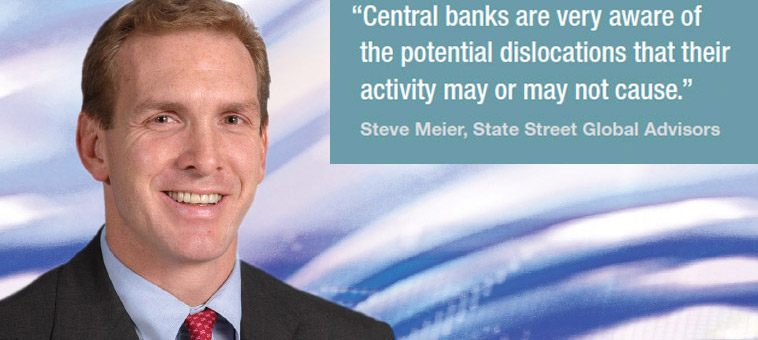SWIMMING WITH GOVERNMENTS.
Government agencies are issuers, rival investors, market regulators and controllers of interest rates; how do asset managers handle them? Dan Barnes writes.
Central banks and government treasury departments are the blue whale of capital markets, largely well-meaning, enormous beasts. Swimming in the same pool of liquidity as these giant government agencies can be an uncomfortable experience.Driven by macro-mandates such as ‘stabilise prices’ and ‘drive sustainable growth’ they make big moves to support the economies of their respective countries. Those mandates do not include consideration of the effect that policy has upon the buy side.
“Certainly within the Euro area quantitative easing (QE), negative policy rates and a big non-profit maximising play within the market are all having quite a profound impact on the approach to fixed income and credit markets,” said David Riley, head of Credit Strategy at BlueBay Asset Management at the Bond Liquidity event held by Shearman and Sterling in July 2016. “I would say the biggest concerns that we have are in terms of the impact on liquidity and the impact on a well-functioning corporate market.”
Ashlin Kohler, director for EMEA Rates and Credit eCommerce, Citi, speaking at the same event, also noted several side effects of central bank policy; “Quantitative easing has created a very one-sided market and that has created a liquidity crunch as well. Additionally the low-yield environment has completely changed what clients want to trade and hold.”
The role of the central banks is not to support investors, and therefore they do not check their engagement in capital markets against the impact on asset management. Rather it is the role of the investment manager to avoid getting caught out by waves generated by the central bank.

Charlie Diebel, global head of rates at Aviva Investors says QE does not necessarily have immediate portfolio management implications as a portfolio manager who has done their job properly will be meeting their liabilities with the assets they already have.
“QE is intended to have certain impact on the yield curve to bring about macro-economic consequences, namely to drive yields lower to force credit out into the real economy,” he notes. “So that in itself makes it that much harder to meet your return. The impact is more at the margin.”
Riding the waves
It has more direct implications for market mechanics, as by removing a significant chunk of free float from the market it reduces liquidity, directly affecting the trading desk.
“It makes it harder necessarily to find the issues that you want, or they can end up trading ‘special’,” Diebel says. “[Central banks] have tried to address this by effectively offering back securities to the market so that the issues don’t go tight on repo, so people can borrow bonds. But without a doubt that has some cost implications and arguably is not the most efficient way.”
Trading around illiquidity in the market then becomes the challenge, as a result of central bank activity. It may mean firms trading cash bonds, as a way of getting risk on-board, or a move to trade futures or do more with credit default swaps (CDS).

Bryan Wallace, insurance fixed income portfolio manager at JP Morgan Asset Management, says, “We have been pushing a lot on derivatives here, and we are actively trading CDS, but I do feel that we would be more active going forward specifically if the ECB continues to reduce the liquidity in the market.”
Firms trading swaps will have to set aside assets to be used as collateral, as mandated by regulation on both sides of the Atlantic and many Asian markets. Derivative trades must be centrally cleared, and therefore backed by collateral, but uncleared trades are equally subject to capital adequacy rules around the cost of holding positions. Even if cash instruments are available there are challenges.
“The flip side is if you want to take off risk quickly you are not able to do that in a cash-only mandate or cash-only business and at that point you must be in a situation where you can buy protection on the various indices that are out there,” notes Wallace.
Evolutionary process
Where a government is both issuing and buying its own debt, its agencies have to have clear segregation to avoid any dislocation in prices. The Bundesbank buys bonds on behalf of the German government but it is actually the German government that is the issuer. In the US, the Federal Reserve was responsible for buying bonds when the QE programme was underway there, but the US Treasury issued the bonds.

Steve Meier, the chief investment officer for fixed income, currency and commodities (FICC) at State Street Global Advisors says, “They are a facilitator to some extent, and all of these central banks are very aware of the potential dislocations that their activity may or may not cause. They go to quite significant lengths to monitor the market and make sure that dislocations don’t occur.”
At one point the Bank of England reportedly artificially created gilts to enable shorts to be covered and repo trades to be carried out. This unorthodox capacity of government agencies to create assets, and act as both buyers and sellers reflects the lack of a regulatory framework around government bond markets, necessary to give them the flexibility to manage monetary and fiscal policy. Yet that in itself raises an issue. If a government bond market suffers a liquidity event, a temporary pricing spike, or even unusual trading activity what is the recourse for buy-side firms in addressing such issues?
Meier, who represents SSGA on the Federal Reserve Bank of New York’s Treasury Market Practices Group (TMPG) says, “We and other firms of our size on the buy- and sell-side are advisors to the central banks and regulatory bodies. We have the privilege of acting as a sounding board for those institutions.”
Groups like this give the buy side regular representation, albeit for larger firms for the most part. Yet where concerns have been raised, for example the 15 October 2014 flash crash in US treasuries, wider market consultations have created a broader channel of communication between central banks, government agencies and the buy side. Although the multi-agency report on the flash crash failed to find a definite cause, blaming the general rise of automated trading and withdrawal of traditional bank liquidity, it did lead the Treasury to open a public consultation on secondary market reform in April 2016 in order to address concerns. The TMPG was instrumental in building policy around the result, making such groups a core route for buy-side firms to influence government agencies.
“Broadly speaking you would say that the US Treasury has oversight of the regulator not the other way around,” Diebel observes. “So arguably they don’t need the regulator, because they are the ones that are the guys that regulate the market. I don’t think that’s the primary concern of the market.”
The big splash
Back to the trading desk. As the European Central Bank has extended QE into the regulated corporate bond market, buy-side dealers will need to watch for both the initial splash as the bank surfaces, and the void that is left as it dives out of sight. Once the programme draws to a close and the purchasing of bonds is reduced, the market will react with ‘taper tantrums’. The impact in credit will be much the same as it was in government bonds, says Wallace.
“If everyone was to try and reduce risk, knowing that that buyer of last resort will disappear at some point in time, the pressure on spreads to tighten has now diminished,” he notes. “The reality is if the market were focused more on fundamentals then spreads wouldn’t be as tight as they are. It’s the technical set that have driven markets and if you remove them, everyone will head for the exit door.”
For a small to medium sized asset manager splashing about in the rates and credit market, knowing this should lead them to be prepared.
“That [opportunity] is small because banks are reducing their ability to warehouse a lot of the spread and you really have to find a buyer,” says Wallace.
©TheDESK 2016
©Markets Media Europe 2025










